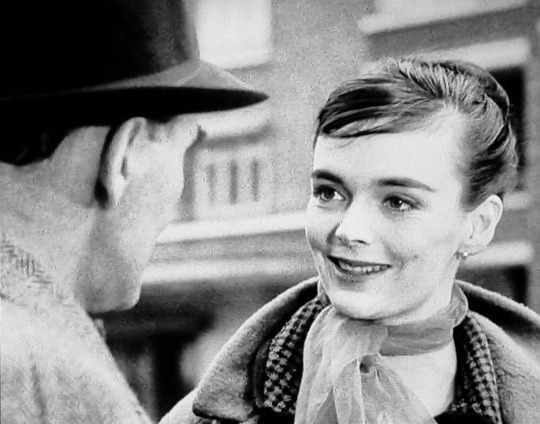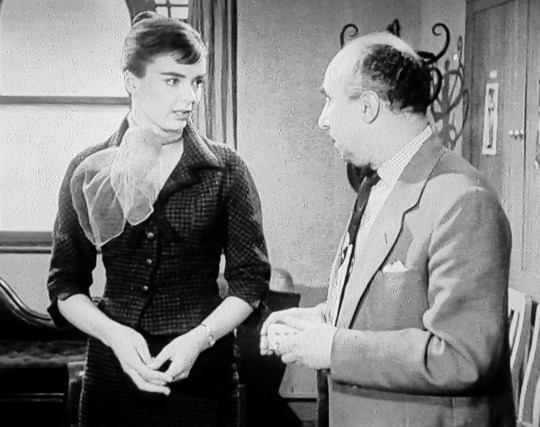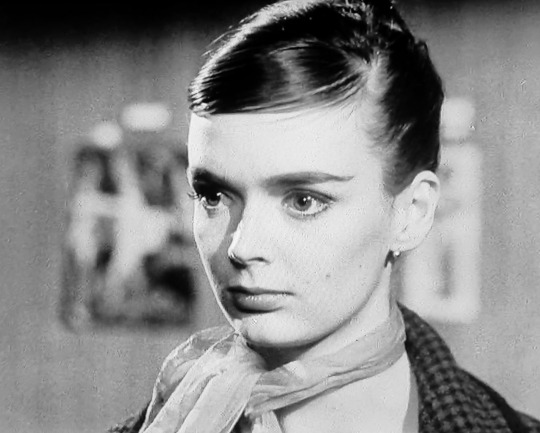#unnerving gothic horror films of the era‚ working with the best directors in the genre
Text



A pre-horror stardom Barbara Steele makes her screen debut as teenage runaway Toni Miller in Dial 999: Missing Persons (1.6, ABC, 1958)
#fave spotting#barbara steele#dial 999#missing persons#1958#classic tv#abc#horror films#scream queen#within a few short years of this first ever screen role‚ Barbara would be an internal sensation and a proto scream queen#known for her horror film appearances in the UK‚ the US and (perhaps most iconic) in Italy#black sunday‚ the pit and the pendulum‚ castle of blood... over the next decade she would make some of the most memorable and#unnerving gothic horror films of the era‚ working with the best directors in the genre#perhaps unsurprisingly‚ having found such success so young‚ her genre tv credits are very few; in the uk she made just this episode#of Dial 999 and‚ seven years later‚ a single Danger Man appearance. mostly she was kept busy in Italy where she fast became the face#of beautiful gothic terror.. as i said in the Pat Troughton and Bill Hartnell posts‚ finding an exact transmission order for Dial 999#seems pretty fruitless‚ but most online sources agree this was shown 6th (network have it as episode 8 but lord knows what order they're#following‚ possibly they just bunged them all on disc in any old order). toni miller is said to be 19 in the script‚ which i raised an#eyebrow at‚ but actually Barbara was only 20 at the time; she carries herself with a lot confidence and professionalism for such a young#performer (and again‚ this was literally her first screen work). it's not the most rewarding part (she's the passive innocent strung along#by a serial killer of runaway girls) but she brings a certain starry eyed naivety to it that's more charming than the script suggests#oh god i just saw an earlier tag says internal sensation when i meant international.. but I'm on mobile and can't edit tags#pretend pretend
6 notes
·
View notes
Text
Loved to Death: Top Five Gothic Romances for Valentine’s Day
Valentine’s Day may at first seem like the antithesis to any horror fan’s dream holiday. Regardless of relationship status, it seems hard for us fiends to enjoy a holiday so sweet and loving, without a trace of blood or bats in sight. But romance has in fact enjoyed a long love affair with horror. In fact, Gothic horror, one of the earliest and most influential genres of horror, is frequently centered around romance.
Gothic horror was originally a literary genre, but in the era of horror film, it has moved from the page to the screen. Gothic horror films frequently depict the darker side of romance, making them the perfect pick for a spooky Valentine’s Day. So if you want to add some terror to your love story this year, check out our top five Gothic romance picks.
Crimson Peak (2015)
If you can only watch one Gothic romance, make it this. Guillermo Del Toro is a master of distilling every genre he takes on and creating films that are essentially the ultimate take on that genre. Nowhere does he do this better than Crimson Peak (2015). Del Toro’s take on Gothic horror is a masterpiece of atmosphere, construction, visuals, and theme. It flawlessly captures the essence of the entire Gothic romance genre in a single film.
Crimson Peak stars Mia Wasikowska as Edith Cushing, an American heiress and aspiring writer in late 19th century New York. As a child, Edith was visited by the ghost of her mother, who warned her to “beware of Crimson Peak.” Now a young woman, Edith is writing a novel, a ghost story on the surface, though she explains the ghost is really a metaphor for the past. Her dismissive male publisher wants her to include a love story. Early on, Del Toro establishes direct references to key themes of Gothic horror, while foreshadowing the story to come.
Edith is an intelligent, independent woman whose literary aspirations evoke the bold female authors who made Gothic romance the iconic genre we know today. I’m certain it’s no coincidence Wasikowska was cast in the role, after so perfectly embodying the most famous of Gothic heroines in Jane Eyre (2011). Edith meets Thomas Sharpe (Tom Hiddleston), a British nobleman traveling with his sister, Lucille (Jessica Chastain). Thomas hopes that Edith’s father will invest in his clay mining enterprise. The investment doesn’t happen, but Edith falls in love with the mysterious nobleman, and after her father meets a violent death, she marries him and moves into his crumbling manor in England. Once there, she is thrown into a nightmare of ghosts, murder, and secrets.
Crimson Peak is a perfect deconstruction, and reconstruction, of Gothic horror. It takes key themes of the genre and examines them with depth and detail. The film brilliantly explores memory, family, the past, British aristocracy vs. American new money, the role of women, and the perils of new love and trust. With the relationships in Crimson Peak, Del Toro handles the tropes of Gothic love stories with incredible understanding and insight. There are really three love stories at play in the film, only one of which could be considered healthy. One of them is downright twisted, and all of them reference prominent tropes in the Gothic genre.
Crimson Peak is a visually rich, emotional, and frightening film. Del Toro can take on any genre of horror with brilliance, and his homage to Gothic romance is no exception.
Jane Eyre (2011)
You can’t talk about Gothic romance without mentioning Jane Eyre. Charlotte Bronte’s 1847 masterpiece of romance, horror, mystery, and proto-feminism laid the groundwork for most modern iterations of the Gothic romance. While Bronte’s novel was not by any means the first of the genre, arguably every Gothic romance since owes a measure of debt to Jane Eyre. The novel is a masterpiece of swooning, slow burn romance, incredible characters, and horrific dark secrets. As is to be expected with any iconic novel, there are plenty of film adaptations to choose from. My pick for the best is the 2011 Jane Eyre directed by Cary Fukanaga. I’m a massive fan of the novel, and for me, Fukanaga’s adaptation hit all the right notes.
Jane Eyre follows the eponymous heroine (Mia Wasikowska) — an orphan who survives a hellish childhood. As a bright, independent young woman, she takes a position as a governess at the mysterious Thornfield Hall. There she begins to fall for the brooding Mr. Rochester (Michael Fassbender). But the dark secret of Thornfield threatens to destroy their passionate romance. The 2011 Jane Eyre is a faithful adaptation that manages not to feel rushed within its two hour runtime. Wasikowska and Fassbender give incredible performances, as does the supporting cast — including Judi Dench, Sally Hawkins, Imogen Poots, and Jamie Bell.
Jane Eyre is more heavy on the romance than the horror, but the novel and film do feature a distinctly spooky atmosphere and some supremely creepy scenes. And when this Jane Eyre goes Gothic, it does so very effectively. From Jane’s childhood ordeal in a room that she believes to be haunted, to the disembodied laughter and nighttime mysteries of Thornfield Hall, Fukanaga had me on the edge of my seat with careful lighting and sound design. And when this film is more romance than horror, it delivers perfectly handled characters and incredibly raw emotion. The only disappointment of this adaptation is that it cut the most terrifying sequence in the original novel. I love romance, but the more horror in the mix, the better. But since Jane Eyre succeeded so brilliantly in every other aspect, I’ll forgive this fault.
If you want to witness an effective and faithful adaptation of a monumental classic, Jane Eyre (2011) is a must see.
I Walked with a Zombie (1943)
From the ultimate Gothic romance genre maker to an exceedingly creative retelling. My next pick is Val Lewton’s haunting re-imagining of Jane Eyre, I Walked With a Zombie (1943). This film marked Lewton’s second horror project after the hugely influential masterpiece, Cat People (1942). I Walked With a Zombie continued the producer’s partnership with director Jacques Tourneur. Lewton’s work with Tourneur would include his very best horror films, and I Walked With a Zombie is no exception. Like Cat People, Zombie was made on a shoestring budget, using a cheesy title provided by the studio via focus groups. But also like Cat People, Lewton would use these limitations to make a frightening, beautiful, and stunningly creative film.
I Walked With a Zombie follows Betsy Connell (Frances Dee), a Canadian nurse who travels to the Caribbean to care for the catatonic wife of Paul Holland, the owner of a sugar plantation. While there, Betsy falls in love with her employer, and begins to except there may be a supernatural source behind his wife’s illness.
I Walked With A Zombie predates the modern horror conception of a zombie, as originated in Night of the Living Dead (1968). Instead, the 1943 film concerns the original concept of a Zombie in Haitian folklore. The subject is handled with surprising care and accuracy for 1943. Lewton and his writers did extensive research on voodoo beliefs and practices for the film, and the depiction of rituals feels almost like a documentary. Furthermore, the film doesn’t shy away from the underlying influence of slavery on zombie practices and beliefs. The film uses the lingering trauma of slavery as a central theme, making for a film that while still flawed, feels overall very ahead of its time. After all, horror is the genre where some of the most socially conscious filmmaking can be found.
Like his first horror film with RKO, Lewton creates some seriously scary sequences using shadow, sound, and suggestion. Betsy’s moonlit journey through the cane fields is intensely creepy — it’s possibly my favorite scene in all of Lewton’s films. As a Gothic romance, I Walked With a Zombie stands out. It takes a familiar structure and story beats, and transports them. Far from the misty moors and crumbling castles of England, I Walked With a Zombie instead gives us the humid nights, shadowy cane fields, and moonlit rituals of the Caribbean. This creative switch results in a new take on a classic genre that is sure to stick with you.
Rebecca (1940)
Alfred Hitchcock’s adaptation of Daphne du Maurier’s novel is a classic work of gothic romance. Hitchcock is known as “the master of suspense” for a reason, and Rebecca proves exactly why. The film manages to take a story where the primary threat is merely memory and guilt, and transform it into a work of horror.
Rebecca follows an unnamed protagonist (Joan Fontaine) working as an assistant to a wealthy woman traveling in Monte Carlo. While there, she sees a man appearing to contemplate suicide on a cliff, and stops him. The man is the aristocratic Maxim de Winter (Laurence Olivier). The two fall in love and are married after only two weeks of knowing each other.
The new “Mrs. de Winter” moves into her husband’s estate, Manderlay. While settling in, the timid young bride feels overwhelmed by the lingering presence of Maxim’s dead first wife, Rebecca. Her monogram is everywhere, her bedroom remains preserved — everywhere she goes the new Mrs. de Winter is reminded that she can never live up to Rebecca. The unnerving presence of Mrs. Danvers (Judith Anderson), the housekeeper who is obsessed with her late mistress, does little to ease the young bride’s fears. Rebecca, like the novel it is based on, draws heavy influence from Jane Eyre. Like the 1847 novel, Rebecca concerns a working class young woman who falls fast for a mysterious aristocrat — only to find the secrets of her new love’s past will continue to haunt him, and her.
Rebecca is a tour de force of atmosphere. Hitchcock makes Manderlay seem present and unnerving through his mastery of pacing, cinematography, and suspense. The performances in the film are steller. Joan Fontaine balances naivete, fear and strength as the unnamed protagonist. Olivier is the ideal of a haunted Gothic hero, and Judith Anderson embodies an iconic villain as the unhinged Mrs. Danvers.
Gothic stories are most often about the horror of the past. Ghosts and curses may serve as the surface scares, but they always represent the true terror of the past sins and traumas our characters are attempting to escape. Rebecca creates a gothic horror without the metaphor, and makes the ghost at its center literally a memory. But it proves that memory can have just as much power, perhaps even more so, than any specter haunting a castle’s halls.
The Brides of Dracula (1960)
A hidden treasure of Hammer Horror, The Brides of Dracula makes up for what it lacks in Christopher Lee by being a wonderful and entertaining take on a Gothic romance by way of vampires. Brides of Dracula follows Marianne Danielle (Yvonne Monlaur), a young woman traveling through Transylvania to take a teaching position at a girl’s school. She is a woman in the mode of the classic heroine of Gothic horror; Young, intelligent, but without wealth or social status. She is perfectly poised for a Byronic hero to sweep her off her feet.
Before long, Marianne encounters just such a hero. Or so she thinks. Stranded by her carriage, Marianne accepts the hospitality of the Baroness Meinster (Martita Hunt), who tells Marianne of her insane son, who she must keep locked away for his own safety. Marianne is horrified, and when she encounters the young man, she is swept away by his fairy tale good looks and piteous state. She sees him as perfectly sane, imprisoned by a cruel mother to keep him from his inheritance. She believes she alone can save him, and frees him. But it soon becomes apparent that the young Baron Meinster is not the romantic hero he seemed to be. Before long, peasant girls are turning up dead, and Dr. Van Helsing (Peter Cushing) is on the case.
Brides of Dracula is a fantastic addition to a gothic romance marathon. It flips the tropes we know and takes them fully to the dark side. It forces us to question the themes of Gothic romance by showing how terribly wrong they could go. The Gothic love interest is always flawed, haunted, and dangerous. While the threat posed by any given Byronic hero can vary, they usually at least genuinely fall for the Gothic heroine. But Baron Meinster is all deceitful predator. He embodies the stereotype of the tortured, beautiful aristocrat who needs saving. And he does this intentionally to draw women into his trap. The ruse works, not only on our heroine, but on other women as well. All of them are blinded by the fantasy sold to them by the genre, which the film more than suggests its characters have read too much of.
Along with a great examination of the dark side of Gothic romance, The Brides of Dracula boasts the stunning cinematography, technicolor color palette, and incredible costumes fans of Hammer Horror have come to expect. And while the film lacks Christopher Lee as Dracula, Peter Cushing literally slays as Van Helsing. He adds the intriguing suggestion of a love triangle to the film. This is also Van Helsing in serious badass mode. During the climax of the film, the vampire hunter pulls one of the most hardcore moves in the character’s entire screen history.
If you want your Gothic romance less swooning, and with more vampires, The Brides of Dracula is the film for you!
Diving into Gothic romance is a great way for to explore ideas of love and loss through the lens of horror. Gothic romance gets at the complexities of love, possibly better then any other genre. It features true love, but also unhealthy love, controlling love, imperfect love, lost love, and terrifying love. It seems fitting that one of the strongest of human emotions be paired with fear. If you want to forgo the candy hearts and dive straight into raw emotion, romance, and terror, let Gothic horror be your Valentine this year.
The post Loved to Death: Top Five Gothic Romances for Valentine’s Day appeared first on Nightmare on Film Street - Horror Movie Podcast, News and Reviews.
from WordPress https://nofspodcast.com/loved-death-top-five-gothic-romances-valentines-day/
via IFTTT
0 notes